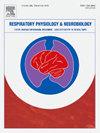罗氟司特(一种磷酸二酯酶-4 (PDE4)抑制剂)可诱导新生大鼠体外制备的呼吸频率可塑性,这种可塑性对炎症具有抵抗力
IF 1.6
4区 医学
Q3 PHYSIOLOGY
引用次数: 0
摘要
早产儿和新生儿经常会出现长时间的呼吸暂停,并容易受到细菌感染,从而进一步影响呼吸。磷酸二酯酶-4(PDE4)抑制剂药物会增加吸气运动活动,似乎会诱导吸气频率的长期增加("频率可塑性")。为了测试 PDE4 抑制剂药物是否会诱导频率可塑性,我们分离了新生大鼠的脑干脊髓,并将其置于沐浴施用的罗氟司特(10 分钟,0.02-1.0 µM)中。罗氟司特能以浓度依赖性方式急性增加爆发频率并诱导频率可塑性。阻断蛋白激酶A(PKA)或cAMP激活的交换蛋白(EPAC)信号通路可消除罗氟司特诱导的频率可塑性的诱导,但不能维持这种可塑性。从注射了脂多糖(LPS,0.1 毫克/千克,3 小时前)的新生大鼠身上分离出的脑干脊髓在沐浴施用 0.05-0.5 µM 罗氟司特后表现出频率可塑性,但在较低浓度下则没有。这表明罗氟司特诱导的频率可塑性在很大程度上能抵抗 LPS 诱导的炎症。因此,罗氟司特能快速增加吸气爆发频率,即使在炎症持续期间也能诱导频率可塑性,这可能具有重要的临床意义。本文章由计算机程序翻译,如有差异,请以英文原文为准。
Roflumilast, a phosphodiesterase-4 (PDE4) inhibitor, induces respiratory frequency plasticity that is resistant to inflammation in neonatal rat in vitro preparations
Premature and newborn infants often have prolonged apneas and are susceptible to bacterial infections that further disrupt breathing. Phoshodiesterase-4 (PDE4) inhibitor drugs increase inspiratory motor activity and appear to induce a long-lasting increase in inspiratory frequency (“frequency plasticity”). To test whether a PDE4 inhibitor drug induces frequency plasticity, neonatal rat brainstem-spinal cords were isolated and exposed to bath-applied roflumilast (10 min, 0.02–1.0 µM). Roflumilast acutely increased burst frequency and induced frequency plasticity in a concentration-dependent manner. Blockade of protein kinase A (PKA) or exchange protein activated by cAMP (EPAC) signaling pathways abolished the induction, but not the maintenance, of roflumilast-induced frequency plasticity. Brainstem-spinal cords isolated from neonatal rats injected with lipopolysaccharide (LPS, 0.1 mg/kg, 3 h prior) expressed frequency plasticity following bath-applied roflumilast at 0.05–0.5 µM, but not at lower concentrations. This shows that roflumilast-induced frequency plasticity is largely resistant to LPS-induced inflammation. Thus, roflumilast increases inspiratory burst frequency acutely and induces frequency plasticity even during ongoing inflammation, which could have important clinical implications.
求助全文
通过发布文献求助,成功后即可免费获取论文全文。
去求助
来源期刊
CiteScore
4.80
自引率
8.70%
发文量
104
审稿时长
54 days
期刊介绍:
Respiratory Physiology & Neurobiology (RESPNB) publishes original articles and invited reviews concerning physiology and pathophysiology of respiration in its broadest sense.
Although a special focus is on topics in neurobiology, high quality papers in respiratory molecular and cellular biology are also welcome, as are high-quality papers in traditional areas, such as:
-Mechanics of breathing-
Gas exchange and acid-base balance-
Respiration at rest and exercise-
Respiration in unusual conditions, like high or low pressure or changes of temperature, low ambient oxygen-
Embryonic and adult respiration-
Comparative respiratory physiology.
Papers on clinical aspects, original methods, as well as theoretical papers are also considered as long as they foster the understanding of respiratory physiology and pathophysiology.

 求助内容:
求助内容: 应助结果提醒方式:
应助结果提醒方式:


